The Castle is located in the center of the medieval town of Vigoleno, on the spur of a hill at about 500 metres above sea level in the municipality of Vernasca on the border between the provinces of Piacenza and Parma.
The area is of great naturalistic interest for the discovery of marine sediments and fossils dating to the tertiary and quaternary era, and for the Vigoleno grotte discovered during the second half of the 800’s a few metres north of the town.
The area is also famous for excellent wines especially Vin Santo of Vigoleno.
The Castle is protected by two surrounding walls, one medieval and the other renaissance.Three different portcullis, embrasures, Ghibelline battlements and traces of a draw-bridge preceed the entrance to the village and the castle.
The third portcullis leads to the fountain piazza which represented political power and where Casa Tanzi is located. Formerly a tower for garrisons with prisons and cellars, it became a residence in the XIX-XX Centuries.
The history of the village is indissolubly tied to that of the Castle. Its origins go back to an ancient Roman settlement, later the Longobards fought off the Hungarians. In 1141 the Castle became property of the city of Piacenza to then belong to the Scotti Family in the XIII Century up to the beginning of the 900’s.
The Castle is rectangular in shape, the tower has a mullioned window and three caryatids, and the rooms were refurbished during the XVII-XVIII Centuries when fireplaces, coffer ceilings and frescos were added. The tower was a refined literary and cultural center during the second half of the 600’s and today is in a perfect state thanks to the artistic and historic renovations.
Worthy of mention the scenographic theatre created thanks to Duchesse Ruspoli Gramont with frescos of the Russian painter Jacovleff.
Gabriele D’Annunzio, Mary Pickford, Elsa Maxwell, and Arthur Rubinstein crossed the walls of the Castle in the 1920’s.
Parts of the Film Ladyhawke directed by Richard Donner and staring Rutger Hauer and Michelle Pfeiffer were shot at the Vigoleno Castle.
The religious monuments of interest are the Oratorio della Beata Vergine delle Grazie and the Pieve of San Giorgio.
The Oratorio was built during the XVI Century. The XVIII Century side alters are dedicated to the Madonna del Rosario and Saint Francis. A 1515 fresco of the Beata Vergine delle Grazie feeding Baby Jesus decorates the main alter.
The Pieve of San Giorgio is a Romanic construction which dates to the XII Century. A fresco of Saint George killing a dragon and one of the Incoronation of The Virgin are located in the main apse.
Sources:
“Piacenza e la sua provincia” di Leonardo Cafferini, Nuova Litoeffe, Castelvetro Piacentino; 2005
Picture: wikipedia
I castelli del Ducato di Parma e Piacenza
Comune di Vernasca


